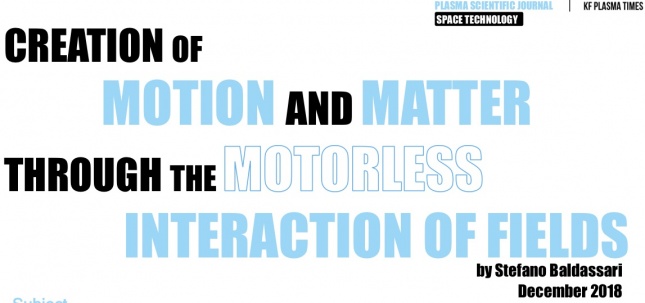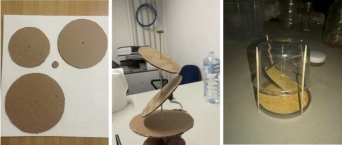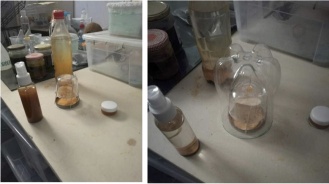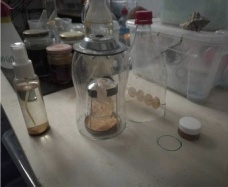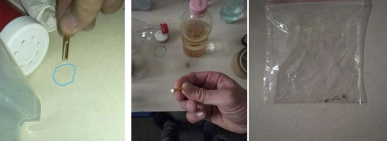Creation of Motion and Matter Through the Motorless Interaction of Fields
This article is part of the KF Plasma Times December 2018
Keywords: field interaction, motion, creation of materials, CH3 discs.Published: December 2018.
Subject
This experiment aims to replicate the motion of the plasmatic fields as it occurs on every level of the existence in the Universe. The hypothesis is that the interaction of plasma fields of higher order can create a condition of motion at the physical level of the system. The second question for this experiment to answer is - where does matter get created in such a simple system. Is it at a fixed distance from the centre, around the system? Is there a pattern to it?
Method
This work is inspired by the paper by M.T. Keshe titled “Creation of motion in the Universe” (Keshe, 2014) and his various workshops. This experiment tries to verify if one can replicate this motion by the field interaction and transfer of it into the inertia of the matter state of the system. The following describes the materials used in this experiment, the basic concept behind it and expected results.
Materials
- CH3 GANS
- Spray bottle
- Cardboard
- Scissors
- Scotch tape
- Cotton wire
- Compass
- Little container
- Wood sticks
Concept
In the initial version (v.1) of the system, the proportions of the amino acid chain (COHN) are taken as a reference, representing an existing dynamic system. Rings of different diameter (according to the atomic mass of these elements) are cut and sprayed with the CH3 GANS.
- 1cm diameter paper disc to replicate atom size of H
- 12cm diameter paper disc to replicate atom size of C
- 14cm diameter paper disc to replicate atom size of N
- 16cm diameter paper disc to replicate atom size of O
The four discs of different diameter are assembled as follows. The largest one sits in the base of a little container. A cotton wire is used to hang the two middle discs with a knot under each to fix them to that position. The top (smallest) disc is fixed on top, outside the container with a piece of tape.
The four discs (as in Figure 1) are positioned at different angles so that during the field transfer from the higher (O gradient disc) to the lower (H gradient disc) the fields are subject to compression and expansion as they travel across the different levels. This leads to three layers of free plasma (one layer between each set of adjacent discs) which in totality may lead to matter motion and/or manifestation of fields in matter strength. The last step involves positioning three containers of different volume, filled with CH3 GANS to introduce ‘compatible’ fields into the outside environment of the system – depicted in Figure 2.
The second version of this system (v.2) follows a different set of principles. Firstly, it operates in the horizontal axis and it’s composed of seven, equal diameter cardboard discs, with different size holes in their center (Figure 3).
The different hole-size is to create a different gradient in the free plasma which gets created inside each disc, leading to the creation of different materials in between different sections of the entire frame. Such system is placed in a plastic cover, positioned next to the v.1 and put to test for the creation of material – as in Figure 4.
Worth noting is the fact that there were couple of other GANSes and GANS productions present in the room. As visible in the background of Figure 4, CO2 production box is positioned on the table, next to the experiment setup. Other GANSes (mostly CH3) are 55cm to 1m away from the center of the experiment setup.
Observations
The first system (v.1) was monitored for 13 days to observe if any change occurs in the position of the discs, which were physically isolated from the environment. A change of position would indicate that the Magrav pressure created between the external environment (three GaNS bottles) and the system is transferred into the matter state. Such physical confirmation would provide a practical understating of the interaction of fields, their positioning and how to operate the future systems. One implementation of this idea is to design a compass to identify sources of high field pressure. V.2 of the system was moved several times but very quickly after stabilizing its position, some matter started to build up around it. In 2-3 days, one could observe multiple, little rocks or grains of some black matter, around the system.
Results
After 2 days from setting up the system (v.1), some motion was observed but it could have been caused by other factors, which have now been addressed. Further observations with the aid of a
digital camera will follow to verify and quantify the movement, if it occurs under a set of more controlled conditions.
The second system (v.2) was very quick to produce, and still produces (on its own or in combination with v.1), large number of small amounts of black material scattered on the surface of the table, around the setup - Fig. 5. Some pieces of matter were found in a close proximity to the CH3 GaNS bottles (few milliliters) while other were found in the distance between 9 and 11 cm from the center of the system; with one piece observed 65cm away from the system. Some of these react to a neodymium magnet and hence operate in the iron field strength but others are composed of different matter which is yet to be identified. Interestingly, once the material is picked up, it does not appear in the same spot again. Another interesting observation is that after leaving a magnet (acting as an antenna) close to the system setup, the iron material deposit by itself on the magnet.
Acknowledgements
Thanking M.T.Keshe for the knowledge, Carolina De Roose for her inspirations; Pete W. for the help with preparing this paper. My wife for being patient.
References
Keshe, M.T. (2014). Creation of Motion in the Universe. Available online https://usastore.keshefoundation.org/store/product/Creation_Motion_Universe/
Supplementary material
Pictures and videos of the progress of this experiment can be found in the following folder: https://www.dropbox.com/sh/au8roekownycw87/AADA2Zl0m3_oDP1K7Fq7A36Ya?dl=0
